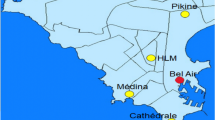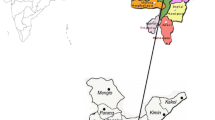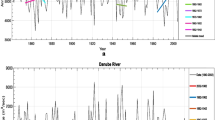Summary
A system identification-based lightning peak current estimation algorithm using upper-air radiosonde observations is developed. The preceding convective and precipitative process leading to thunder cloud formation followed by the cloud electrification and the leader processes together with return stroke and the discharge process, is identified by considering it as a deterministic dynamic system, whose undisturbed and unmeasurable output signal – the lightning peak current, is contaminated with a stochastic disturbance. The model parameters determined thus, are used to predict the likely temporal lightning return stroke peak current magnitudes. Two alternative parametric estimation models namely Autoregressive with Exogeneous Input (ARX) and Autoregressive with Moving-Average Exogeneous Input (ARMAX) are used to estimate model parameters of the pilot study area and predict the likely lightning return stroke peak current in each case. The relative performances of the models are compared to determine the best model for application in 12-hour and 24-hour ahead predictions. For a short-term (12 hour) prediction, ARMAX2921 giving a best fit of 78.8429% turns out to be the most suitable model. For a longer (24 hour) prediction, the ARX291, giving a best fit of 75.0181% emerges to be the suitable model. These preliminary results indicate that lightning peak current may be estimated to a good performance using upper-air radiosonde observations.
Similar content being viewed by others
References
Bazelyan EM, Raizer YP (2000) Lightning physics and lightning protection. Institute of Physics Publishing, Bristol
Brieman L, Friedman JH, Olshen RA, Stone CJ (1984) Classification and regression trees. CRC Press
Burrows WR (2001) Statistical models for lightning prediction using Canadian lightning detection network observations. 16th Conf. on Probability and Statistics in the Atmospheric Sciences, AMS
Burrows WR, King P (2000) Neuro-statistical models for predicting lightning occurrence in Canada: Climatology and potential predictors, 9th GLOMW, Toronto
V Cooray (1998) ArticleTitlePredicting the spatial and temporal variation of the electromagnetics fields, currents, and speeds of subsequent return strokes. IEEE T Electromagn C 40 IssueID4 427–435
V Cooray (2003) ArticleTitleOn the concepts used in return stroke models applied in engineering practice. IEEE T Electromagn C 45 IssueID1 101–108
V Cooray C Gomes (1998) ArticleTitleEstimation of peak return stroke currents, current time derivatives and return stroke velocities from measured fields. J Electrostat 43 163–172 Occurrence Handle10.1016/S0304-3886(97)00169-1
MR Gavric (2002) ArticleTitleIterative method for waveshape restoration of directly measured lightning flash currents. IEE Proc. Generation, Transmission, Distribution 149 IssueID1 66–70
C Gomes V Cooray (2000) ArticleTitleConcepts of return stroke models. IEEE T Electromagn C 42 IssueID1 82–96
Hair JF, Anderson RE, Tatham RL, Black WC (1998) Multivariate data analysis, 5th edition. New Jersey: Prentice Hall
F Heidler JM Cvetic BV Stanic (1999) ArticleTitleCalculation of lightning current parameters. IEEE T Power Deliver 14 IssueID2 399–404
Krider EP, Roble RG (panel co-chairmen) (1986) The earth’s electrical environment. Washington DC: National Academy Press
YM Li J Kuffel W Janischewskyj (1993) ArticleTitleExponential fitting algorithms for digitally recorded h.v. impulse parameter evaluation. IEEE T Power Deliver 8 IssueID4 1727–1735
Ljung L (1999) System identification: Theory for the 2nd edition. New Jersey: Prentice Hall
TR McComb JE Lagnese (1991) ArticleTitleCalculating the parameters of full lightning impulses using model-based curve fitting. IEEE T Power Deliver 6 IssueID4 1386–1394
J Perez J Martinez (1996) ArticleTitleKalman filter algorithm for digitally recorded lightning impulse parameter evaluation. IEEE T Power Deliver 11 IssueID4 1713–1719
J Perez J Martinez (1998) ArticleTitleDigitally recorded lightning impulse with overshoot parameter evaluation by using the Kalman filtering method. IEEE T Power Deliver 13 IssueID4 1005–1014
WA Peterson S Rutledge R Orville (1996) ArticleTitleCloud to ground lightning observations from TOGA COARE: Selected results and lightning location algorithms. Mon Wea Rev 124 602–620
CP Price D Rind (1992) ArticleTitleA simple lightning parameterization for calculating global lightning distributions. J Geophys Res 97-D9 9919–9933
VA Rakov MA Uman (1998) ArticleTitleReview and evaluation of lightning return stroke models including some aspects of their application. IEEE T Electromagn C 40 IssueID4 403–426
R Solomon M Baker (1994) ArticleTitleElectrification of new mexico thunderstorms. Mon Wea Rev 122 1878–1866 Occurrence Handle10.1175/1520-0493(1994)122<1878:EONMT>2.0.CO;2
H Torres O Trujillo et al. (1999) ArticleTitleDesign, construction and calibration of three devices to measure directly lightning parameters. High Voltage Engineering Symp. Conf. Publication 467 2,430–2,433
Uman MA (1987) The lightning discharge. London: Academic Press
Unbehaun H (1980) Lecture notes on system identification by parameter estimation methods. CISM Seminar of Identification of Vibrating Structures of the International Centre for Mechanical Sciences, Udine, Italy
Zajac BA, Weaver JF (2002) Lightning meteorology: an introductory course on forecasting with lightning data. Symp. on Advanced Weather Interactive Processing System. Florida, Amer Meteor Soc
Author information
Authors and Affiliations
Rights and permissions
About this article
Cite this article
Wern, T., Mukerjee, R. Lightning peak current estimation using a system identification approach. Meteorol. Atmos. Phys. 91, 25–44 (2006). https://doi.org/10.1007/s00703-005-0135-x
Received:
Revised:
Accepted:
Published:
Issue Date:
DOI: https://doi.org/10.1007/s00703-005-0135-x




